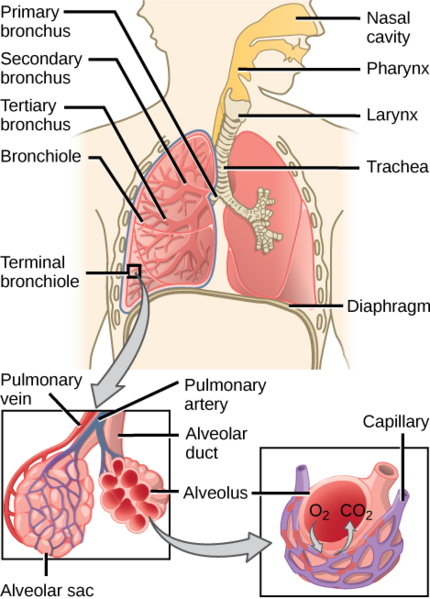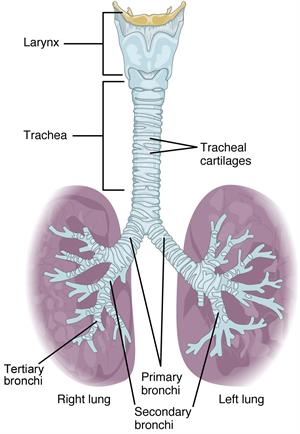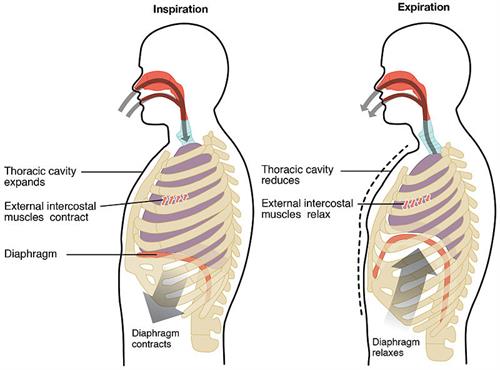PDF chapter test TRY NOW
The special features of the respiratory system of mammals include a nose, the complete separation of the nasal passage from the buccal passage, long windpipe or trachea, well-defined neck, and lungs.

Human respiratory system
The following organs are the parts of the respiratory system, which is located in the thoracic cavity or chest cavity:
1. Nostrils: Nostrils are the paired openings that open into the two nasal cavities, separated from each other by nasal septum (thin cartilage partition). Inhalation and exhalation occur through the nostrils. The inner lining of the nostrils is lined with hair epithelium and goblet cells that secrete mucus.
The mucus makes the passage sticky and moist. In addition, the mucus and the hair in the nostrils help in the filtering of dust particles and microorganism present in the inhaled air. The inhaled air is also warmed up when it enters the nasal passage.
2. Pharynx: The pharynx is a tube-like structure that is common to both air and water. It attaches the trachea to the nasal cavity. It runs down to the lungs through the trachea.
3. Larynx: The pharynx opens into the larynx through an aperture called the glottis. The larynx is the uppermost part of the trachea, which is made of \(nine\) cartilages.
The cartilaginous epiglottis covers the glottis. The larynx is also called the voice box (produce sound by the vibration of tissues present) and is more prominent and protruding in a man called Adam's apple.
4. Trachea: The larynx leads to the trachea, composed of cartilaginous rings of cartilage. The trachea is a narrow tube that extends up to the mid-thoracic cavity. Cartilaginous rings prevent the collapse of the trachea in the absence of air.
Thus, the primary function of the trachea is to allow the inhaled air to the lungs and the exhaled air back from the body. The trachea is also lined with cells that have cilia and secrete mucus.
The trachea enters into the lungs after it branches into the bronchi (singular bronchus). The end of the trachea divides into two bronchi which enter the left and right lung. Bronchi are further divided into multiple small units called bronchioles which ends in the alveolus.

Bronchial tree of respiratory system
6. Lungs: Lungs are the organs that aid in the gaseous exchange. They are also called as pulmones. They are situated in the thoracic cavity that facilitates gaseous exchange through the diffusion of gases through alveoli.
7. Alveoli: Alveoli is the primary functional unit of the lung, richly supplied with blood capillaries. They are thin-walled and looks like tiny bubbles within the sacs. In addition, there is the presence of a single layer of epithelial cells.
Nearly \(480\) \(million\) alveoli are present in human lungs. The surface area of alveoli is large and vary around \(100 m^2\). The large surface area and the thin-walled nature of alveolar cells allow gases to diffuse easily across the cells.
Passage of air through the human respiratory system
Nose
Nostrils
Nasal passage
Nasal cavity
Pharynx
Larynx
Trachea
Bronchi
Bronchioles
Alveoli
Capillaries of the blood
Breathing
Breathing is associated with the inspiration and expiration of air between the atmosphere and the lungs' alveoli. The diaphragm and the intercostal muscles control it. The diaphragm is a dome-shaped smooth muscle that differentiates the thoracic cavity from the abdominal cavity.
As we have seen in lower classes, during inhalation, the diaphragm contracts and descends. The sternum and the ribs are pushed up and outwards. The volume of the thoracic cavity thus increases which creates negative pressure inside the lungs. Thus, the lungs inflate and draw in air from outside the body.
During exhalation, the diaphragm relaxes and returns to the dome shape. The sternum and the ribs return to the original position. The volume of the thoracic cavity decreases, which creates a positive pressure in the lungs. Thus, the lungs return to the original position, and thus air is expelled from the lungs.

Inspiration and Expiration
Reference:
https://commons.wikimedia.org/wiki/File:Figure_39_01_06.png
https://commons.wikimedia.org/wiki/File:2316_Inspiration_and_Expiration.jpg
https://cnx.org/contents/SNnPNNz9@1.3:VflMihYl@1/OU-Human-Physiology-Organs-and-Structures-of-the-Respiratory-System
